Japanese Gefilte Fish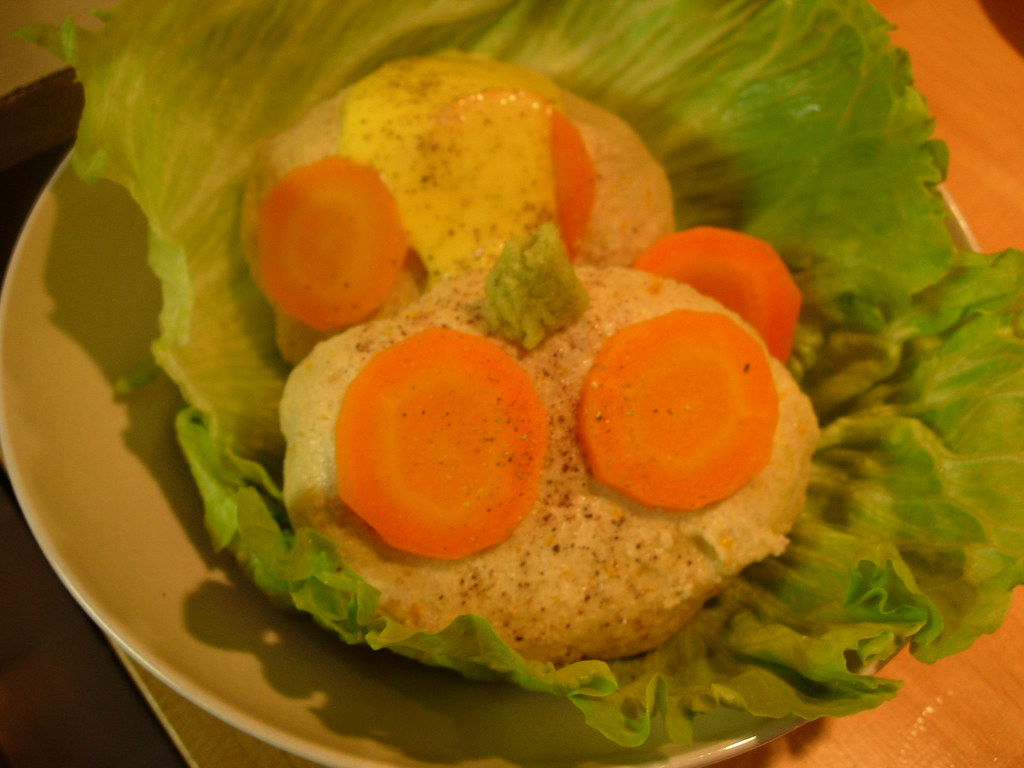
The Passover season crept up on me this year. Not being surrounded by a distinguished crew of Judaic Studies scholars as I usually am, I just didn’t notice. Besides, it’s not like there are a whole lot of Jews here, so the stores don’t fill up with matzoh as an early warning. In fact, so far as I can tell, you can’t get matzoh here for love or money, making Passover food rather tricky.
Fortunately, my mother sent me two boxes of Streit’s matzoh meal some months ago, for making matzoh ball soup, which the kids love — you should see Maia trying to eat a matzoh ball the size of a baseball. Other than that, the Passover season is pretty awful here if you’re observant (which I’m not) and follow the Ashkenazi tradition, which means you can’t eat rice, corn, or legumes in addition to any grain flour. That means you can’t eat much of anything here except vegetables and meat, and you can’t have seasoning with them, because most seasoning here involves soy sauce and/or sake, which is rice wine.
Now as I say, I’m not observant, but I generally make some effort to pay attention to the Pesach rules. I do cheat and follow the Sephardi rules about flour: rice and legumes are OK, though I don’t think you’re supposed to make bread out of them. That of course makes everything much easier. No, as far as I know I’m straight-up Ashkenazi, but I’m not above a little self-serving shifting around, and the Sephardim do have better food. Besides, it doesn’t really make that much difference from a Jewish legal standpoint: since I normally eat things like pork and shellfish, it’s pretty much irrelevant which version of the Pesach rules on leaven I decide to sort of obey.
In any event, one thing a lot of non-Jews don’t understand about Passover is that despite all the food restrictions, it’s really a very big food holiday. There are certain foods that are special Passover things, and although you can eat them any time, they’re extra-special at Passover. I suppose, though, that every Jewish holiday is a big food holiday, except for Yom Kippur when you fast. Well, anyway, Passover is big food.
Among the most famous, or infamous, of the Passover dishes is gefilte fish. Lots of people hate this, but lots of people haven’t had the good stuff. If you think gefilte fish comes in jars, for example, you haven’t had the good stuff.
You also have to like fish, I suppose, but it’s pretty mild and un-“fishy” if you use decent fish. And you have to like horseradish, the standard accompaniment.
Good fish? Horseradish? In Japan? You see my line of thinking....
Gefilte Fish 101
As far as I understand it, originally gefilte fish was stuffed fish: gefilte, filled. You took a whole salmon, gutted and boned it intact, and then stuffed it full of minced white fish (whitefish, pike, carp are the classics) mixed with matzoh meal and vegetables. Then you poached the whole thing in a strong stock made of all the bones and skins. You served it hot or cold, in the latter case often glazed with a bit of the jellied stock.
Now think about Thanksgiving turkey or whatever. You know how the turkey is pretty good, maybe, but the stuffing is evil and always eaten in much greater quantity? Okay, so let’s suppose you just made the stuffing by itself, but kept calling it “Thanksgiving turkey” anyway. Same thing: gefilte fish is the stuffing all by itself.
You take white fish, carrot, onion, egg, matzoh meal, and oil, and you make a fairly smooth puree. Then you poach fat patties of the stuff in a strong fish stock. You chill the patties, and serve them with horseradish sauce or relish. It’s usual to poach a whole carrot with the patties and serve it in slices.
Now I haven’t seen whitefish or pike here, and carp is I think out of season. But there are lots of good white fish here, and it’s not expensive to buy stuff good enough to eat raw. Carrots and eggs are easy and good, negi scallion substitutes well for onion (not that you can’t get onion, but negi have a nice bright flavor), and for horseradish wasabi root seems to be in season right now. Matzoh meal is tricky, but as I say, Mom sent me a bunch.
Making Gefilte Fish
If you want to play along at home, the recipe I more or less used is this one. Why? Because the 2d Avenue Deli is brilliant.
So, first, I bought about three pounds of white fish fillets and steaks. I bought buri and karei. Buri is Japanese amberjack, a species of yellowtail. Karei is a kind of flounder, actually a lot like sole.
Now I considered buying these things whole, but buri are huge, and I didn’t see any nice big fillets. As to karei, I just didn’t see any whole ones that didn’t cost a fortune, but cut ones were inexpensive, don’t ask me why. The problem is that when you buy cut fish here, it usually has a lot of bone in it, as well as the skin, and it’s a lot harder to deal with these in little pieces of fish than it is with whole ones. Nevertheless, I bought pieces. This meant half an hour removing bones and skin.
Fortunately, I have pretty good knives for this purpose. In fact, I had just sharpened my yanagiba (sashimi knife), used for skinning and for cutting the boneless flesh in slices or chunks, which speeded things along. In this photo, the really big knife is a gyutō, or Japanese-style chef’s knife; the thick black thing is a deba-bōchō, for dealing with whole and bone-in fish; and the thin shiny knife is the yanagiba, which is only used on boneless fish. For some reason the shine doesn't show well in this picture.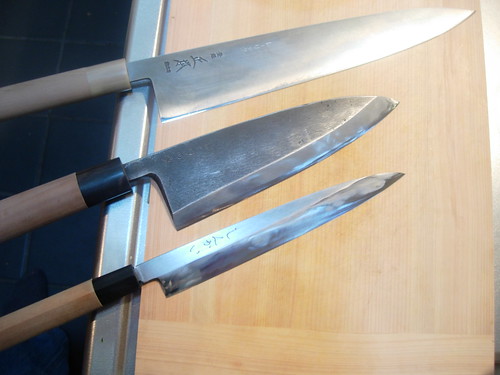
Actually, I had a disconcerting experience with this: as I was skinning the fish with that shiny yanagiba, and thinking how easy it is when your knife is really, really sharp, I got careless and just barely touched the tip of my left thumb with the blade.
The effect was electric. Instantly, the hair stood up on the back of my neck and I got a cold feeling in the pit of my stomach. I carefully put down the knife and started washing my hands, knowing I was going to have a nasty, bloody cut. In fact, however, I had to look hard to see it: at the tip of my thumb, in the very surface layer of skin, there is a small, perfectly straight cut. No blood, no nothing. But when I touched that blade that way, I knew. In case you were ever wondering what a very, very sharp knife is like, that’s one (extremely unsafe) way to know: if you touch the blade straight-on and get this reaction, it is very, very sharp.
In passing, there is a fun way to know if your knife is really sharp — not necessarily scary sharp, but sharp. Put the knife on its spine, edge up, on the board. Take a cherry tomato and hold it about a foot above the edge, and drop it. If the knife is really sharp, the tomato will cut cleanly. Isn’t that cool? I love this.
Anyway, other than nearly cutting myself in thin slices, it wasn’t that bad a process, just a little tedious.
Next I minced some carrot and negi and a bit of ginger. When in Kyoto....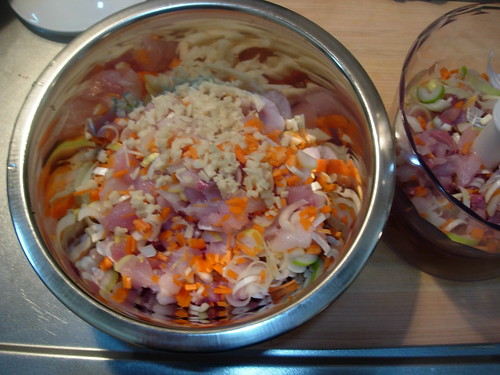
Into the processor, and whizz! Took several batches, of course, because my processor is tiny. Then add beaten eggs, oil, salt, white pepper, and sugar, and stir well.
Incidentally, there seem to be a lot of people who freak out at the notion of sugar in gefilte fish. Why? Because they don’t know anything much about cooking. A little sugar goes into quite a number of dishes that aren’t sweet, because it helps bring out certain kinds of flavors. This is why you add it to tomato sauce, for example. And some kind of sweetness is extremely common in Japanese fish dishes, usually in the form of mirin (sweet cooking sake). With gefilte fish, the last thing you want is for the flavor to be dull or flat, so you use a little sugar. Why not?
Anyway, it looked like this after I beat it smooth.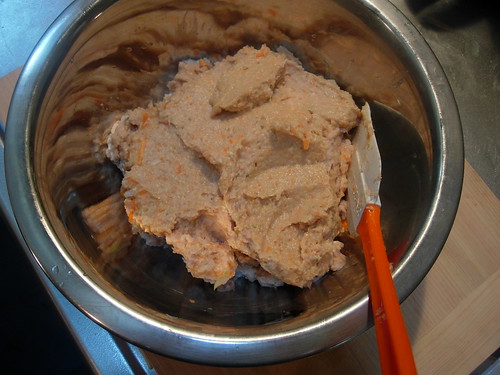
Then I added matzoh meal and beat it smooth again.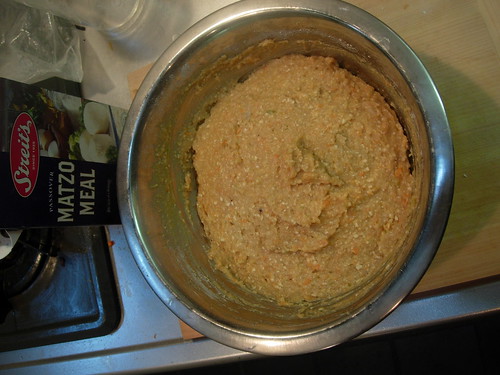
Isn’t that delicious-looking? I knew you would. In any event, I covered it with plastic and put it in the fridge to set up and develop flavor.
About 10 hours later or so, when it was convenient, I cooked the stuff.
Along with the fish itself, I’d bought two packages of fish heads and bones for making simmered tai no ara, on which see this entry.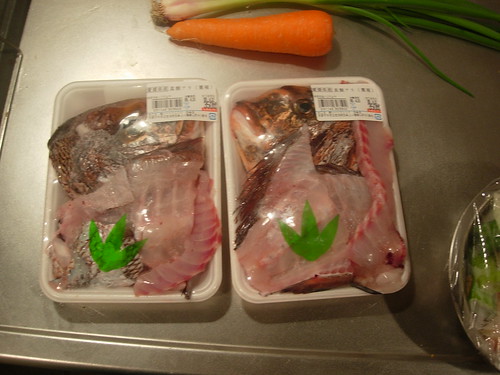
Yum! Fish heads!
I put these, all the trimmings from the fish and carrots and such, and some more carrot into a pot with a lot of water, then brought it gently to a boil, skimming scum as necessary. The puree I made into big lumps, sort of halfway between balls and patties. You do this with wet hands or stuffing of any kind sticks like mad.
These patties I gingerly lowered into the pot. Here I had a bit of trouble: I had so much trimmings and stuff for the soup that the patties were going to get impaled on bones. I put a colander in the pot over everything, which was fine, but I didn’t have a whole lot of space because the pot is too small. They fit in, just, so I left the lid on the pot, and figured they’d half-simmer, half-steam, which is fine — you want that with matzoh balls, for example, because they’re lighter that way. But then the things started to expand, which always happens when you cook stuff that has matzoh meal in it, which of course I hadn’t thought of. Argh! So I pulled out half and cooked them in two batches, which of course took an extra 90 minutes. Oh well. At least that gave me time to remember the carrot, which I forgot initially.
This is what they looked like straight out of the pot.
They went into the fridge covered with plastic, along with the carrot. Then I strained the stock, let it cool, and refrigerated it. (Useful tip: never cover hot stock and shove it in the fridge, because it tends to breed bacteria. Let it cool uncovered, then cover and refrigerate. If your kitchen is very hot, plan ahead and freeze several heavy-duty freezer bags full of water, then drop these in and stir in order to cool the stock rapidly without diluting it. But I digress.)
Preparing the Dish
The weather is medium-warm at the moment, and gefilte fish are really better cold, so that’s how I served them.
For some strange reason, the stock didn’t gel. I can’t think why, considering how much bone and stuff simmered in it for how long, but it didn’t. Thus I couldn’t glaze my gefilte fish, and I’m just saving the stock to make fish soup with.
For horseradish, I used fresh wasabi. Since it is essentially unavailable outside Japan, let me show you what it looks like and what you do with it. Here is a wasabi root, not very good quality, which cost about $6: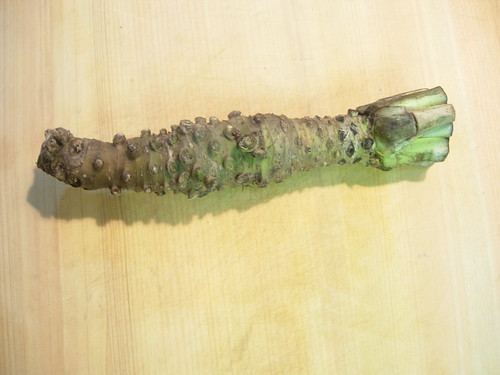
First you scrape the really dark stuff off the outside using the back of a knife, then cut off the very tip.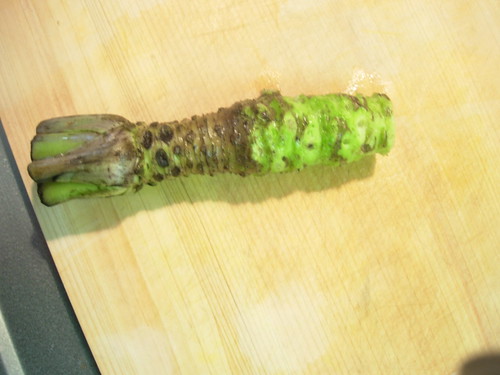
Then, as shortly before serving as possible (the stuff loses flavor rapidly), you grate it using a circular motion on a little grater. I’m using a ginger grater, because I see very little point in buying a sharkskin grater — the best for wasabi — since I can’t get wasabi outside Japan. Besides, a ginger grater works fine.
I decided to try two different approaches here. One is just plain wasabi, in a little ball, the way you see it (or rather, its artificial imitation) in sushi shops. But I also thought something more like a sauce would be nice. One of the most common sauces is mayonnaise, lemon juice, and horseradish, sometimes with beet juice added, so I figured I’d do a variant on that.
I put the juice of one little sudachi lime, a big blob of wasabi, and an egg yolk in a bowl with salt and pepper. Then I beat in oil, part olive and part canola, just the way you’d make mayonnaise.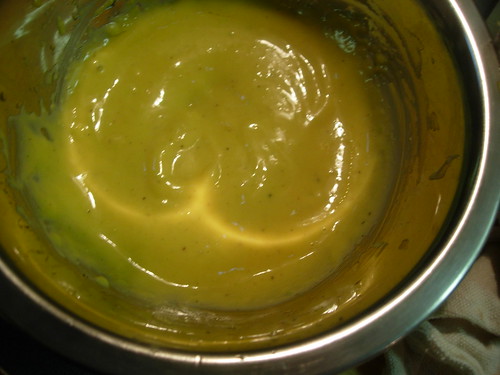
To serve, I put two gefilte fish balls on a bed of lettuce, garnished with slices of the poached carrot, and presented with the two wasabis. Here's the photo again, in case you forgot: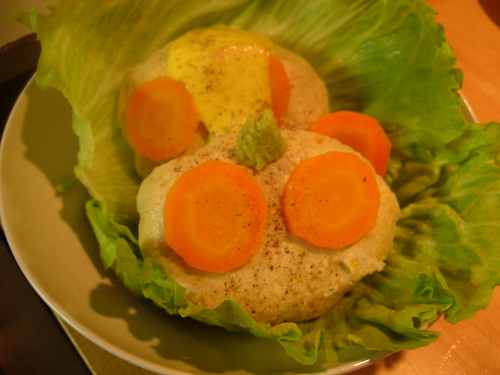
Tasting
The taste was pretty good, but a little flatter than I’d have liked. The main thing was that the fish wasn’t really light enough, probably because buri wasn’t the best choice. It also lacked a bit of that distinctive gefilte fish texture, which is silky smooth, because the stock didn’t gel: if it does gel, you see, the fish balls are partly bound together with gelatin, making them silken. My wife isn't a big fan of that texture, so she didn't mind, but I think gefilte fish are better with it.
The wasabi was definitely not very good quality, and didn’t have nearly sufficient intensity. Straight, it seemed kind of bland, and in the sauce you could barely taste it at all. Still, when I used a fair wodge of the plain and the sauce together, they did come together nicely and had a good flavor.
Maia was okay with it, but only really liked the carrots. Sam insisted that it had to be warm, and then ate a couple of bites, but I don’t think he liked it much either. Mom and Dad ate them fairly happily, on the whole, but as I say I was a little bit disappointed — I made much better ones last year, but I don’t have that recipe with me here.
I suspect that our Japanese friends would like these things. That’s sort of how the whole idea started in the first place, actually, with us musing on how there are certain odd convergences of Japanese and Ashkenazi Jewish cuisine.
All told, a medium success.
Future Attempts
Unfortunately Sam is in school only a couple of hours in the morning for a couple of weeks, so I don’t have a whole lot of time to fool around in the kitchen, but I am planning to do my other gefilte fish recipe one of these days, Passover or no Passover.
See, I have this idea: what if there was a large Jewish population in some great culinary places where, in point of fact, there are basically no Jews? Japan is one, and that produces something like what I just did. Another is New Orleans. So how about gefilte fish, New Orleans-style? I’ve done it at home in Boston, with fair success, but now I’ve got access to much better fish and also know how to cut the things a good deal better. So we’ll see when I have time, but that’s coming up as soon as I can.




2 comments:
Your knife set leaves me all sad about the state of knives that are to be found in my kitchen. Nothing there looks like it could possibly have the edge that your knives have!
I also like the flamingo picture you posted earlier.
Chris
Hi, Chris!
You know, good knives do not have to be excessively expensive, and they can last pretty much a lifetime for home cooks like us. Drop me an email if you want some suggestions.
(Drop me an email anyway, actually!)
Post a Comment